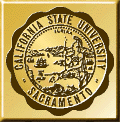EdTe 226
Seminar: Strategies for Teachers
California
State University, Sacramento
Department of Teacher Education
College of Education
Spring, 2000
|
|
|
|
|
|
Catalog Description:
Seminar focuses on analyzing various teaching strategies used in classrooms, K-12. Teaching strategies will be analyzed to identify teacher competencies and learning outcomes. Additional attention will be given to appropriate classroom management strategies.
Prerequisite courses or other requirements:
Students must be admitted to the Curriculum and Instruction Masters' Program. This course may be taken at any time during the program, however, many students take the course during the first part of their coursework. It is best to take it when you have access to students because you will have an audience to try out different strategies.
Number of Units: 3 units
General information:
You will be asked to be a risk taker. There will be many strategies that are already familiar to you, however there will be some that are totally new to you or you may recognize aspects. If you already have expertise in a strategy, you will probably want to skip that strategy (for practicing) and move on to new arenas. That takes courage!
No one is expected to be perfect at first. After observing and participating in a strategy in the university classroom, then reading about the strategy, you will be asked to design a lesson (or lessons) to practice the strategy with students. You will have opportunities to discuss the strategies and the outcomes with other members of the class. Typically, one person has had successes in one area, and can offer advice, whereas another class member has had successes in a different area and can offer advice.
By the end of the course you should have a larger repertoire of teaching strategies, a knowledge of when and why to use strategies and ideas for adapting strategies. Your final project may give you ideas for integrating strategies with one another.
Although it is tempting to talk and think about "our teaching styles", the students in our courses have many learning styles and course materials themselves may "demand" different levels of understanding. Thus, it is important to have a repertoire of teaching strategies to meet the needs of the variety of students we have and to address the variety of levels of understandings incorporated into curricular materials. Many of the strategies also invite integration of curriculum and instruction.
Many candidates in the Masters' Program have accomplished the induction part of teaching (first two years) and are now searching for greater variety in teaching. This course is the place to be!
Students will need an electronic mail account and computer access to the Web. All CSUS students enrolled in one or more units can create a SacLink account for electronic mail and Internet services. Although a home computer with a high speed modem running Netscape or Internet Explorer would be beneficial, students can use the Web from one of the campus student labs. Check out Computer Hardware Recommendations for CSU, Sacramento Students for more information about equipment.
Computing Recommendations
|
Comfortable using the computer and browsing the Web |
|
Windows compatible Pentium running Windows NT,or Windows 95/98 or Macintosh compatible with System 8 |
|
32M RAM (preferably 64M) |
|
28.8K or faster modem - preferably 56K |
|
Microsoft Internet Explorer or NetScape 4.0 (or higher) |
|
SacLink or other Internet Account |
|
Word processing skills |
|
Online class participation on the Web assignments and electronic discussions. |
- Flexible Scheduling: Students generally work full-time, many have family responsibilities, and many live a distance from campus. Being able to complete selected course units from home or work without attending weekly classes should be a major convenience.
- Enhanced Learning: Time saved traveling to and from campus (and looking for parking) can be redirected to learning!
- Adult Learners: As highly motivated learners, students can actively pursue areas of greatest interest rather than sit through lectures aimed at the whole group.
- Increased Interaction with Classmates: Web-based communication tools can actually increase interaction among students by permitting group work that would be difficult to arrange if students had to meet in the same place at the same time.
- Virtual Office Hours: Electronic communication between students and the instructor can actually increase the degree of our interaction, since you can e-mail me at your convenience, rather than find time to get to my office or reach me by phone.
- The Web's the Limit (not the instructor): The World Wide Web has a wealth of resources from which you can learn a great deal more than I can teach you. Everywhere, the role of the faculty is being reconceptualized as that of "coach" rather than "instructor". Students are perfectly suited to take advantage of coaching to get out of the course what will be of most value to them.
- Electronic Competency on the Job: The competence in dealing with electronic environments that you develop in this course will be of great value to you in your workplace.
Successful Student
Characteristics
- Discipline to complete projects by deadlines instead of waiting until the end of the semester.
- Motivation to read, write, and participate fully in class activities.
- Time to devote approximately 9 hours a week to a 3-credit course.
- Ability to work independently and in teams.
- Flexibility in dealing with technology problems.
More information is available on Dr. Pfeifer's homepage. You may contact the instructor via e-mail at pfeifer@csus.edu.
